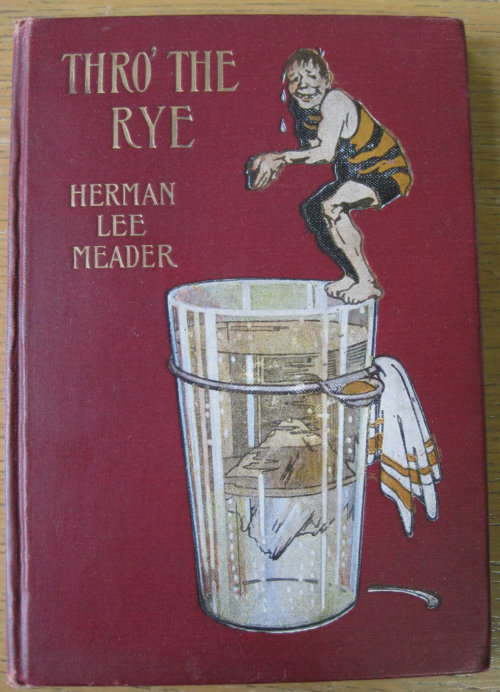#epigrams
The cover of this book featuring an already damp gent about to dive into a glass of rye and soda gives a bit of a hint to its contents. Written by Herman Lee Meader and published by Henry Altemus Company in 1906, Thro’ the Rye: More Reflections is a collection of aphorisms pertaining to various stages of life. Those stages of life, in turn, are paralleled with the stages of whiskey production, from the rye fields to the glass to the after effects of a night spent drinking. For example, the chapter “Blended Spirits” is about marriage and “Sobering Up” deals with uncomfortable or sensitive topics from divorce to poverty. The alcohol theme is not confined to whiskey, as one can tell from the illustrated title page of a maenad riding a boar, and the green borders throughout the book featuring a nude woman and grapevines.
Let’s close with some sound advice from the chapter “High Balls:”
Never make silent motions for the bartender to fill up the glasses. When it’s your turn to treat, shout out! It sounds liberal and costs no more.
Newberry call number: Wing ZP 983 .H394
Post link
(I love this satire of the usual, chatty, pseudo-epigrams of the Alexandrian poets).
Why are you standing next to me?
Why don’t you let me sleep?
Asking who I was, and from where,
and what country I was born in?
Get going, march on past my marker!
I’m Menoitios, Philarkhos’ son, Kretan.
We don’t waste words where I’m from.
(Poseidippos in the Milan Papyrus (fr. 102 Angiò/Cuypers/Acosta-Hughes/Kosmetatou); my translation)
τί πρὸϲ ἔμ’ ὧδ’ ἔϲτητε; τί μ’ οὐκ ἠάϲατ’ ἰαύειν,
εἰρόμενοι τίϲ ἐγὼ καὶ πόθεν ἢ ποδαπόϲ;
ϲτείχε‹τέ› μου παρὰ ϲῆμα· Μενοίτιόϲ εἰμι Φιλάρχω
__ Κρήϲ, ὀλιγορρήμων ὡϲ ἂν ἐπὶ ξενίηϲ.
One of Asklepiades’ defining features as a love epigrammist is the variety he depicts. He’s not alwayspositiveabout it, as in the first case - and in fact he often writes miserably or about misery - but he surveys the breadth of romance and sexuality as he thought of it. Here, therefore, we learn of two lesbian Samians, an exotic (probably Nubian, but she was in any case noted for being both coal-black and ‘native’ instead of Greek) royal mistress to Asklepiades’ ruler Ptolemy Philadelphos, and a woman who likes adolescent youths and, seducing them, dresses in the petasosandkhlamys.
Two women from Samos, Bitto and Nannion, don’t want to
come to Aphrodite on the goddess’ terms.
They’re abandoning her for something else, something wrong. Lady Kypris,
curse their bed, these women who turn their backs on you.
Didyme’s bloom has enchanted me, oh god! I’m
melting, like wax by a fire, in the light of her beauty.
If she’s black, so what? Coals are too; but when
we tend them, they still glow, like a rose’s unfurled petals.
Dorkion, that lover of youths, just like a boy, knows
how to loose the swift arrow of Common Love,
striking them with desire from her eyes like a lightning bolt, and from her shoulders
[…]
with her boy’s hat, her boy’s cloak shows her naked thigh.
(Asklepiades in the Greek Anthology (5.207, 5.210, 12.161); my translation)
αἱ Σάμιαι Βιττὼ καὶ Νάννιον εἰς Ἀφροδίτης
φοιτᾶν τοῖς αὐτῆς οὐκ ἐθέλουσι νόμοις,
εἰς δ᾽ ἕτερ᾽ αὐτομολοῦσιν, ἃ μὴ καλά. δεσπότι Κύπρι,
μίσει τὰς κοίτης τῆς παρὰ σοὶ φυγάδας
τῷ θαλλῷ Διδύμη με συνήρπασεν ὤ μοι. ἐγὼ δὲ
τήκομαι, ὡς κηρὸς πὰρ πυρί, κάλλος ὁρῶν.
εἰ δὲ μέλαινα, τί τοῦτο ; καὶ ἄνθρακες: ἀλλ᾽ ὅτ᾽ ἐκείνους
θάλψωμεν, λάμπους᾽ ὡς ῥόδεαι κάλυκες.
Δόρκιον ἡ φιλέφηβος ἐπίσταται, ὡς ἁπαλὸς παῖς,
ἕσθαι πανδήμου Κύπριδος ὠκὺ βέλος,
ἵμερον ἀστράπτουσα κατ᾽ ὄμματος, ἠδ᾽ ὑπὲρ ὤμων
[…]
σὺν πετάσῳ γυμνὸν μηρὸν ἔφαινε χλαμύς.




